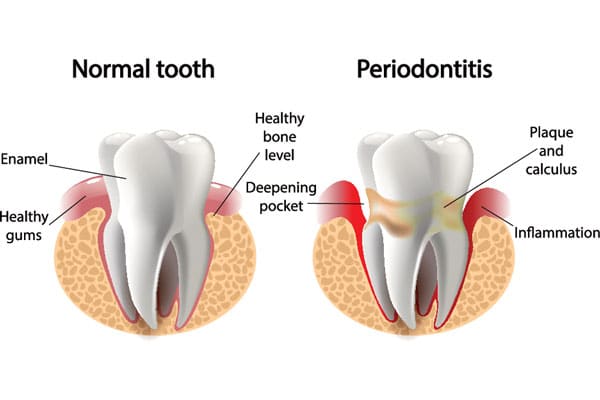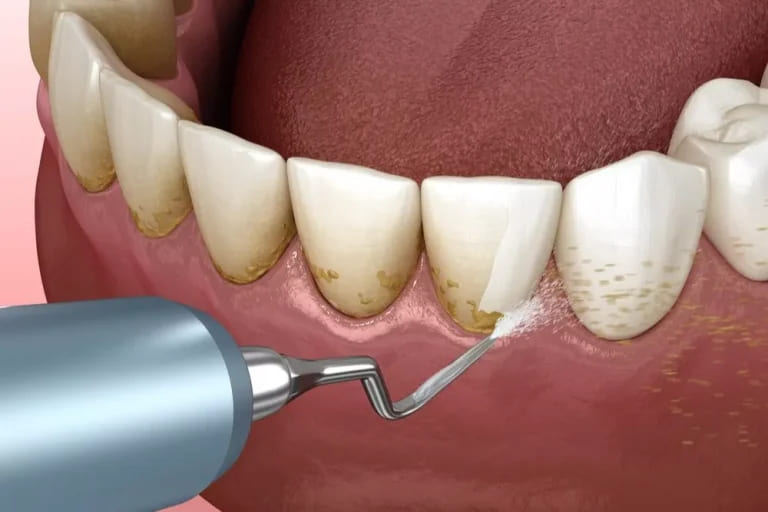If your gums aren’t in good health, your teeth are under constant threat. A ‘deep dental clean’ may be necessary.
How Do Regular Cleanings And Deep Cleanings Differ?
Regular Cleaning – Preventative Care
A regular cleaning by a dental hygienist focuses on the parts of your teeth that are visible above the gum line. The hygienist removes plaque and tartar, polishing away any surface stains. This reduces the risk of gingivitis (gum inflammation) and tooth decay.
Required: Twice a year
Number Of Appointments: One for each cleaning
Results: Immediate
Deep Cleaning (Scaling and Root Cleaning) – Gum Disease Reversal Care
A dental deep cleaning that goes inside the gums. It’s also called scaling and root cleaning. It’s necessary when the gums have become diseased and developed Periodontitis – a bacterial gum and tissue infection which is the main cause of adult tooth loss. A dental hygienist may not perform this treatment and referral to a specialist dentist, Periodontist, may be required
Required: Once
Number Of Appointments: Two to three
Results: Three months
How Do I Know If I Need A Deep Cleaning?
Your dentist should tell you if it’s necessary during a routine check-up, but if you have any of these symptoms you should make an appointment as soon as possible. Gingivitis, if not treated quickly, can become periodontitis. Significant bacteria and tartar buildup can cause pockets to form inside the gum around the roots of your teeth. A nice, warm place for the bacteria to breed! If the bacteria, calculus, microorganisms, and toxins are not removed, periodontal disease is the inevitable result, damaging your teeth, gums, tissues, and jaw bones.

7 Symptoms of Periodontitis
- Bad breath or a foul taste in your mouth that doesn’t go away
- Gums that bleed easily
- Gums that are swollen, red, or purple.
- Pain when you chew or brush
- Pus or new gaps between your teeth
- Teeth that look longer than normal
- Teeth that feel loose or fit differently when you bite
A Deep Clean Is A Two-Part Process
Scaling: The same above the gum line procedure as a regular cleaning.
Root Cleaning: The plaque and tartar is removed from the surface of the roots of the teeth inside the gum. A specialist dentist may be required to carry out this treatment. A follow-up visit may be required as the health of the gums will need monitoring. Results can be seen in about three months.
7 Things To Expect During A Deep Cleaning Treatment
- A local anaesthetic numbing your gums.
- Remove or scale the plaque and tartar from your teeth above and below your gum line.
- Smooth or plane the roots of your teeth.
- An antibiotic injection at the roots of your teeth or an antibiotic prescription.
- A minimal amount of pain and sensitivity usually last for about 5 to 7 days.
- Your gums may bleed during the procedure so tell your dentist if you are taking any blood thinning medication before the procedure occurs.
- After-care instructions.
Poor oral health can significantly impact your quality of life. Your teeth will decay and fall out, and the bacteria will infiltrate your blood stream causing other health issues. Whereas a healthy mouth makes a healthy life more likely.
If you’re not sure if you have gingivitis or periodontitis and want to talk to us about whether you need a regular or a deep cleaning, contact us on 0508 TEAM DENTAL and make an appointment today. Help your teeth stay healthy and strong for life!
FAQs
Q1: What’s the main difference between a regular dental cleaning and a deep cleaning?
A: A regular cleaning is preventative, focusing on visible tooth surfaces to remove plaque and tartar. A deep cleaning (scaling and root planing) goes beneath the gum line to remove bacteria and tartar from tooth roots, treating gum disease like periodontitis.
Q2: How do I know if I might need a deep cleaning?
A: Your dentist can confirm during a check-up, but symptoms like persistent bad breath, easily bleeding or swollen gums, pain while chewing, or loose teeth can indicate you might need a deep cleaning.
